Difference between revisions of "Lizard and Snake Anaesthesia"
| Line 31: | Line 31: | ||
==Monitoring/ Maintenance== | ==Monitoring/ Maintenance== | ||
[[Image:Iguana_maintenance.bmp|200px|thumb|right|'''Maintenance of anaesthesia in an iguana''' (Copyright © RVC and its licensors, Sean Bobbit, Sue Evans, Andrew Devare and Claire Moore. All rights reserved)]] | [[Image:Iguana_maintenance.bmp|200px|thumb|right|'''Maintenance of anaesthesia in an iguana''' (Copyright © RVC and its licensors, Sean Bobbit, Sue Evans, Andrew Devare and Claire Moore. All rights reserved)]] | ||
| + | [[Image:Doppler_iguana.bmp|200px|thumb|right|'''Doppler blood flow monitor positioned for heart sounds''' (Copyright © RVC and its licensors, Sean Bobbit, Sue Evans, Andrew Devare and Claire Moore. All rights reserved)]] | ||
Isoflurane is the agent of choice for maintenance of anaesthesia. Propofol by slow intravenous or intraosseous administration can also be used. | Isoflurane is the agent of choice for maintenance of anaesthesia. Propofol by slow intravenous or intraosseous administration can also be used. | ||
Revision as of 17:46, 4 March 2010
| This article is still under construction. |
Reptiles are becoming more popular pets and so it is becoming increasingly important to understand handling and treatment for these species. They pose a number of different issues compared to that of other domestic species, for example, some may be more dangerous to handle, and so careful selection of agents is required with the ideal providing muscle relaxation, analgesia, easy control and is both safe for personnel as well as the patient. There are also variations in anatomy compared to that of other domestic species. These include the simple sac like structure to lizard and snake lungs.
General Considerations
Changes in temperature can affect physiological systems of reptiles and so temperature regulation is an important consideration when any reptile is hospitalised. During any procedure, the patient should ideally be maintained at their optimum temperature. As many anaesthetic agents are metabolised and/or renally excreted, it is important to maintain the patient's body temperature as these organs can also be affected thereby prolonging recovery from anaesthesia.
Preanaesthetic Considerations
As with any species, a full clinical examination is important before any anaesthetic procedure. This allows for detection of any abnormalities and correction of these before continuing with the procedure.
- Atropine as a premedicant is considered unnecessary except in small reptiles since salivary excretions are generally not a problem.
- Intake of food and water should be monitored so that they can later be used to assess the postoperative recovery. As regurgitation is rare in these patients, starvation is not necessary, although regurgitation is more likely to occur in a snake that has recently fed.
- The use of water baths or electrolyte solutions in the days prior to a procedure may be beneficial in ensuring that a suitable state of hydration is present.
- As in any species, stress should be kept to a minimum, and preplacing a catheter before induction is recommended.
- Intubation of reptiles, compared to some other species, is relatively simple due to the glottis being clearly visible but it is necessary to wait until the glottis is open.
Although the pharmokinetics are not known it is probably worthwhile giving analgesics and anti-inflammatories. Carprofen is the NSAID of choice and analgesics that are being used include butorphanol and buprenorphine.
Antibiotics and fluids may be indicated.
Induction
Induction can be by parenteral injection or gaseous inhalation and the anaesthetic agents are the same as used in mammals.
Parenteral agents include intravenous Propofol and Saffan or intramuscular ketamine. Gaseous agents include isoflurane and halothane which may be administered with an induction chamber or face mask.
- Propofol may be used for induction at a dose rate of 10mg/kg IV in reptiles. It is an excellent anaesthetic if you are competent with IV injections. The anaesthesia may be continued with additional doses of 10% of the original or, more preferably, by isoflurane inhalation
- The constituents of Saffan are alphadolone acetate 3mg/ml and alphaxalone 9mg/ml. The dose is 6 to 9mg/kg IV or up to 15mg/kg IM. It has been superceded by propofol as an IV anaesthetic.
Monitoring/ Maintenance
Isoflurane is the agent of choice for maintenance of anaesthesia. Propofol by slow intravenous or intraosseous administration can also be used.
Where possible, anaesthetised reptiles should be kept in sternal recumbancy, to help with circulation and prevention of hypotension developing. Monitoring the depth of anaesthesia can be difficult in reptiles but may of the same reflexes and response can be monitored as in other domestic species. As in other species, cardiovascular and respiratory systems should also be closely monitored. This can be done using oesophageal stethoscopes, ECGs and blood gas analysis. As previously mentioned it is also important to maintain the patient at its ideal temperature throughout the anaesthetic.
Physical reflexes are especially important since lizards at a plane of surgical anaesthesia may suddenly appear fully awake. This probably occurs from trying to maintain the lizard as light as possible. Reflexes and responses include:
- Toe and tail pinch.
- Head withdrawl - Toe is pinched and head is slightly withdrawn.
- Palpebral response.
- Vent response.
- Tongue response.
- Corneal response.
- Jaw tone.
Intermittent positive pressure ventilation (IPPV) is necessary.
The most important anaesthetic monitoring aid is a Doppler blood flow monitor. A pulse oximeter and an electrocardiograph may also be useful. Advanced monitoring aids include blood gas saturation and capnography. The heart rates of lizards are relatively slow. Normal readings are about 50 bpm. Although readings for pulse oximetry may drop below 70% aim for haemoglobin saturation above 90%.
Postanaesthetic Considerations
Recovery can take between 10-30 minutes on average in reptiles. The patient should be minimally handled or stimulated as to prevent cardiovascular problems. Hypothermia can be a major cause of prolonged recovery as previously discussed. However, care should be taken to make sure that the patient is not overheated as this may lead to necosis and metabolic disturbances. Monitoring of the patient should continue until full normal function is obtained, and provision of oxygen or room air via assisted ventilation may be necessary until spontaneous breathing has returned. The patient may appear to of recovered and then gone back to an "re-anaesthetised" state and rest for periods during recovery. Full recovery may take up to 24 hours.


